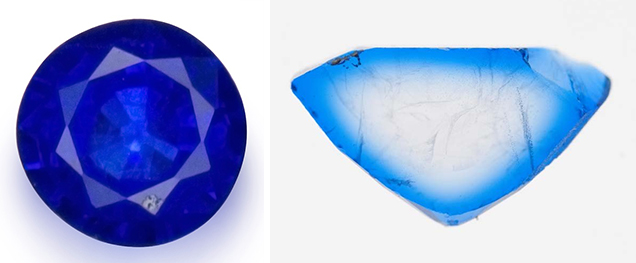GIA Lab Reports on a New Cobalt Diffusion Treatment of Natural Spinel
June 11, 2015

In May 2015, GIA laboratories in New York, Carlsbad, and Bangkok received unusual-looking, strongly colored blue spinels for identification. Other labs, including one in Sri Lanka, reported similar examples, which were determined to have undergone diffusion treatment with cobalt.
Subsequently, the Bangkok-based treater responsible for these cobalt-diffused gems provided GIA with 18 samples ranging from 0.35 to 4.99 ct for this study. He revealed some details of his treatment process, which uses “off-color” natural spinel as a starting material and reportedly involves the use of high-temperature heating with both iron (Fe) and cobalt.
GIA gemologists examined the samples using conventional microscopy, ultraviolet/visible/near-infrared (UV-Vis-NIR) spectroscopy, and analyzed their chemistry using both EDXRF (energy-dispersive X-ray fluorescence) and LA-ICP-MS (laser ablation–inductively coupled plasma–mass spectrometry). Photoluminescence (PL) spectra were also collected.
Magnification revealed features such as healed fractures and altered inclusions that indicated the stones had been exposed to high-temperature heating. The authors report that in some cases it might be challenging to determine whether the starting material is natural or synthetic, due to the highly altered nature of the inclusions. In these cases, PL spectra can help, as synthetic spinel shows distinctly broader Co-related peaks than natural spinel with this technique.
Unlike diffusion-treated corundum, most of these spinels did not show color zoning conforming to the outline of the finished gem (surface-conformal color zoning). However, when some examples were cut into sections (wafers) for LA-ICP-MS analysis, the blue color was clearly confined to the stone’s edge or rim. Additionally, the stones appeared strong red through the Chelsea color filter, as did the treated outer layers of the wafers.
UV-VIS-NIR spectroscopy revealed features characteristic of both Fe and Co, and trace-element analysis confirmed significant concentrations of both elements. Spot testing of one sample with LA-ICP-MS determined that the concentration of Co was much higher in the treated rim (466 ppma) than at the stone’s center (9 ppma). Fe concentration also appeared more elevated at the rim (up to 1070 ppma) than at the center (670–786 ppma).



